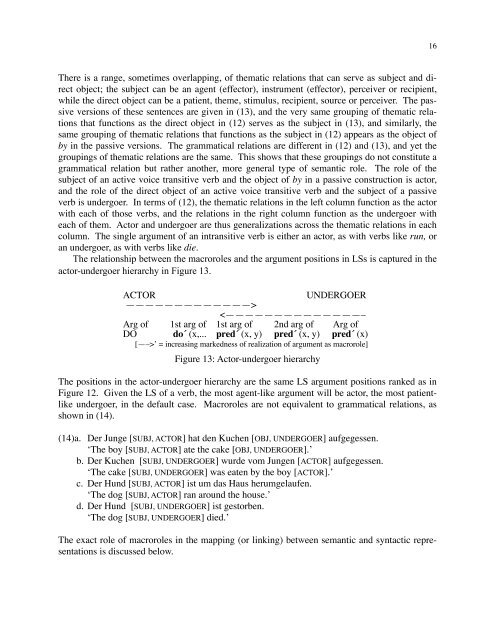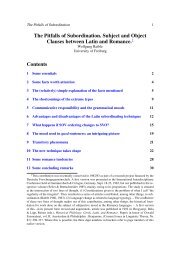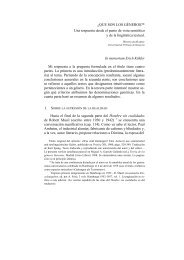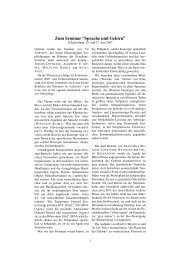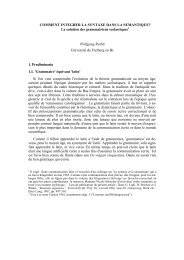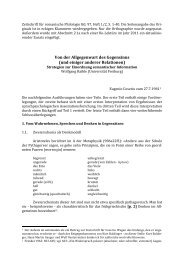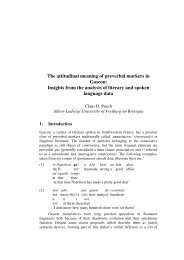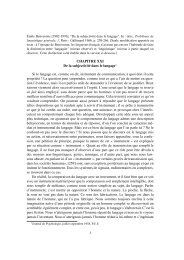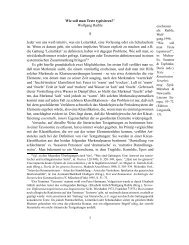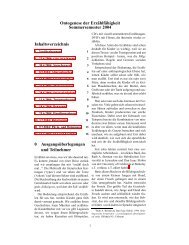A Summary of Role and Reference Grammar
A Summary of Role and Reference Grammar
A Summary of Role and Reference Grammar
Create successful ePaper yourself
Turn your PDF publications into a flip-book with our unique Google optimized e-Paper software.
There is a range, sometimes overlapping, <strong>of</strong> thematic relations that can serve as subject <strong>and</strong> direct<br />
object; the subject can be an agent (effector), instrument (effector), perceiver or recipient,<br />
while the direct object can be a patient, theme, stimulus, recipient, source or perceiver. The passive<br />
versions <strong>of</strong> these sentences are given in (13), <strong>and</strong> the very same grouping <strong>of</strong> thematic relations<br />
that functions as the direct object in (12) serves as the subject in (13), <strong>and</strong> similarly, the<br />
same grouping <strong>of</strong> thematic relations that functions as the subject in (12) appears as the object <strong>of</strong><br />
by in the passive versions. The grammatical relations are different in (12) <strong>and</strong> (13), <strong>and</strong> yet the<br />
groupings <strong>of</strong> thematic relations are the same. This shows that these groupings do not constitute a<br />
grammatical relation but rather another, more general type <strong>of</strong> semantic role. The role <strong>of</strong> the<br />
subject <strong>of</strong> an active voice transitive verb <strong>and</strong> the object <strong>of</strong> by in a passive construction is actor,<br />
<strong>and</strong> the role <strong>of</strong> the direct object <strong>of</strong> an active voice transitive verb <strong>and</strong> the subject <strong>of</strong> a passive<br />
verb is undergoer. In terms <strong>of</strong> (12), the thematic relations in the left column function as the actor<br />
with each <strong>of</strong> those verbs, <strong>and</strong> the relations in the right column function as the undergoer with<br />
each <strong>of</strong> them. Actor <strong>and</strong> undergoer are thus generalizations across the thematic relations in each<br />
column. The single argument <strong>of</strong> an intransitive verb is either an actor, as with verbs like run, or<br />
an undergoer, as with verbs like die.<br />
The relationship between the macroroles <strong>and</strong> the argument positions in LSs is captured in the<br />
actor-undergoer hierarchy in Figure 13.<br />
ACTOR UNDERGOER<br />
—————————————><br />
’ = increasing markedness <strong>of</strong> realization <strong>of</strong> argument as macrorole]<br />
Figure 13: Actor-undergoer hierarchy<br />
The positions in the actor-undergoer hierarchy are the same LS argument positions ranked as in<br />
Figure 12. Given the LS <strong>of</strong> a verb, the most agent-like argument will be actor, the most patientlike<br />
undergoer, in the default case. Macroroles are not equivalent to grammatical relations, as<br />
shown in (14).<br />
(14)a. Der Junge [SUBJ, ACTOR] hat den Kuchen [OBJ, UNDERGOER] aufgegessen.<br />
‘The boy [SUBJ, ACTOR] ate the cake [OBJ, UNDERGOER].’<br />
b. Der Kuchen [SUBJ, UNDERGOER] wurde vom Jungen [ACTOR] aufgegessen.<br />
‘The cake [SUBJ, UNDERGOER] was eaten by the boy [ACTOR].’<br />
c. Der Hund [SUBJ, ACTOR] ist um das Haus herumgelaufen.<br />
‘The dog [SUBJ, ACTOR] ran around the house.’<br />
d. Der Hund [SUBJ, UNDERGOER] ist gestorben.<br />
‘The dog [SUBJ, UNDERGOER] died.’<br />
The exact role <strong>of</strong> macroroles in the mapping (or linking) between semantic <strong>and</strong> syntactic representations<br />
is discussed below.<br />
16


